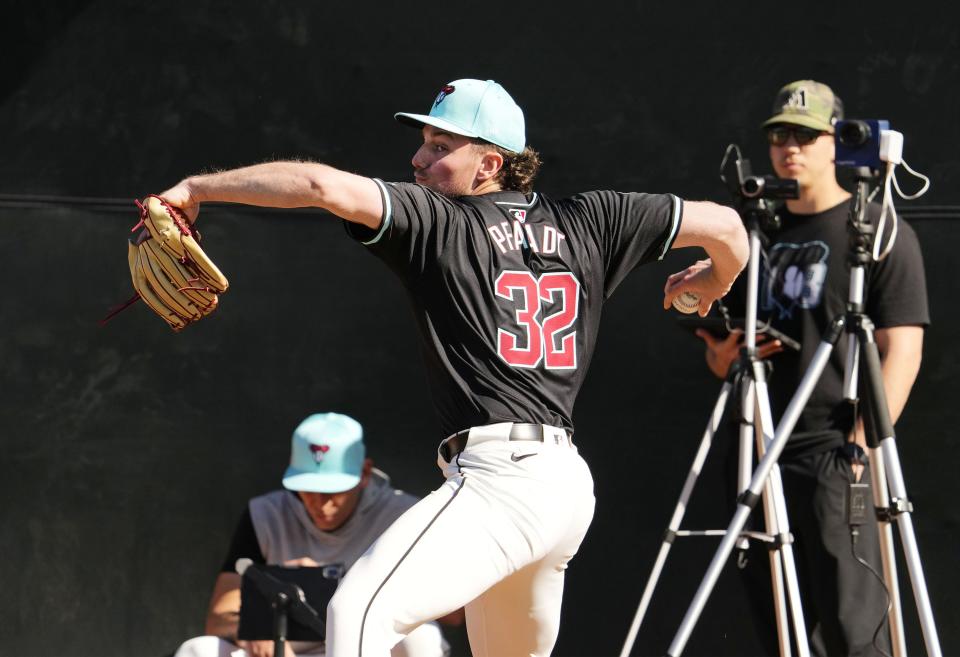Brandon Pfaadt's development crucial for Diamondbacks' future as contenders
One day last week, Torey Lovullo was asked whether Brandon Pfaadt will open the year in the Diamondbacks’ rotation, as their No. 4 starter.
The resulting proclamation did not earn real estate in any headlines or on any news tickers. In a room full of reporters, no one rushed to their phones to post about it on social media. Even the tone of Lovullo’s one-word response — “yeah” — was as if the question was so obvious it didn’t need to be asked.
All of it was very procedural. And all of it was, if you take a step back, just a little bit unusual.
Last season, Pfaadt went 3-9 with a 5.72 ERA. Those are not the typical numbers of a pitcher with a guaranteed spot on a World Series contender’s roster. For a more normal test case, look at Ryne Nelson, who had a 5.31 ERA. Nelson is in the middle of a spring training roster battle in which he needs to prove that he can be better than he was last year. That’s how it normally goes when a starting pitcher’s ERA creeps above 5.00.
Arizona Diamondbacks: Lourdes Gurriel Jr. says he's fine after 'scary' HBP
Pfaadt, of course, is different for a reason: what he did down the stretch and into October. He was a postseason hero, with a 3.27 ERA in five starts. The Diamondbacks won four of those games, including Game 7 of the National League Championship Series, their biggest win in 22 years. Without Pfaadt, their season might have ended a few weeks earlier, robbing this state of its most joyous baseball month in a generation.
“He got on the mound in some really tough environments and didn't blink,” Lovullo said. “And I feel like he deserves that opportunity to go out there as one of our five starters to start the season.”
To Lovullo, the moment that stood out was the first inning of Game 3 against the Phillies. Facing a 2-0 series hole, Pfaadt stepped to the mound and retired Kyle Schwarber, Trea Turner and Bryce Harper in order — three hitters who had destroyed Diamondbacks’ pitching in the first two games. Pfaadt ended up striking out nine in 5 2/3 innings of two-hit ball that night.
“That's where something clicked for him when I was watching it,” Lovullo said. “It was a really impressive moment.”
To an extent, Pfaadt began clicking a few months before that. After struggling mightily in his first two major league cameos, he was called up for a third time in July and showed why he had been the club’s top pitching prospect.
Over 13 appearances between then and the end of the regular season, he had a 4.22 ERA. Crucially, he struck out over a batter per inning, showcasing the tweaks that pitching coach Brent Strom enacted to improve his slider.
But it was in the postseason when everything changed — when Pfaadt transformed from a promising young pitcher to an established piece of the rotation.
“I feel more confident for sure,” Pfaadt said this week, citing that postseason success. “There was a lot on the line in the postseason, win or go home,” he added. “I just flipped the script and went for it.”

Still, Pfaadt knows his progress isn’t done. The postseason showed what he can be at his best, not that he’s a finished product. Only once in that run did Lovullo allow him to face an order for a third time. He never touched the seventh inning.
To continue his growth, Pfaadt is focused on fine-tuning his changeup, a pitch that he threw just 12.1% of the time last year.
“I think that's the key pitch to both righties and lefties for that slider to be more effective,” Pfaadt said.
Last year, the development of Pfaadt’s slider was a crucial factor in his transformation. But even after his third call-up, he combined to throw his fastball and slider nearly 70% of the time, a well-above-average rate. That was necessary largely because of ineffective results with his other pitches. Against the changeup — his third most-used pitch — opposing batters hit .409/.422/.727 throughout the season.
And while Pfaadt turned the slider into his best offering, he wants more consistency there too — a result he saw in his most recent spring training start on Monday.
“I'm seeing that sweep, that normal sweep,” Pfaadt said after that game. “And sometimes when it's backing up, I'm not getting the right spin on it. Either my arm could be dragging, it could be several things. But that's what we're getting our arms in shape to do.”
In the postseason, that slider was at its very best. Opposing batters whiffed at it on 52.3% of swings. Taken over a full season, that number would have placed Pfaadt’s slider fourth among major-league starters, behind only Spencer Strider, Blake Snell and Jacob deGrom.
For the Diamondbacks, pulling everything together to maximize Pfaadt’s skillset is crucial. The floor and ceiling of this year’s rotation would both rise considerably with a fourth reliably above-average starter. And in the long-term, his development into a top-of-the-rotation arm would ameliorate concerns about Zac Gallen and Merrill Kelly, both of whom have two years left on their contracts.
The benefit for Pfaadt is that he can continue that growth without worrying about his job security. He earned that safety net last fall, when he turned 19 turbulent regular-season performances into much more.
“It's awesome,” Pfaadt said. “It gives me a little peace of mind.”
This article originally appeared on Arizona Republic: Brandon Pfaadt's growth outlook for contending DBacks

